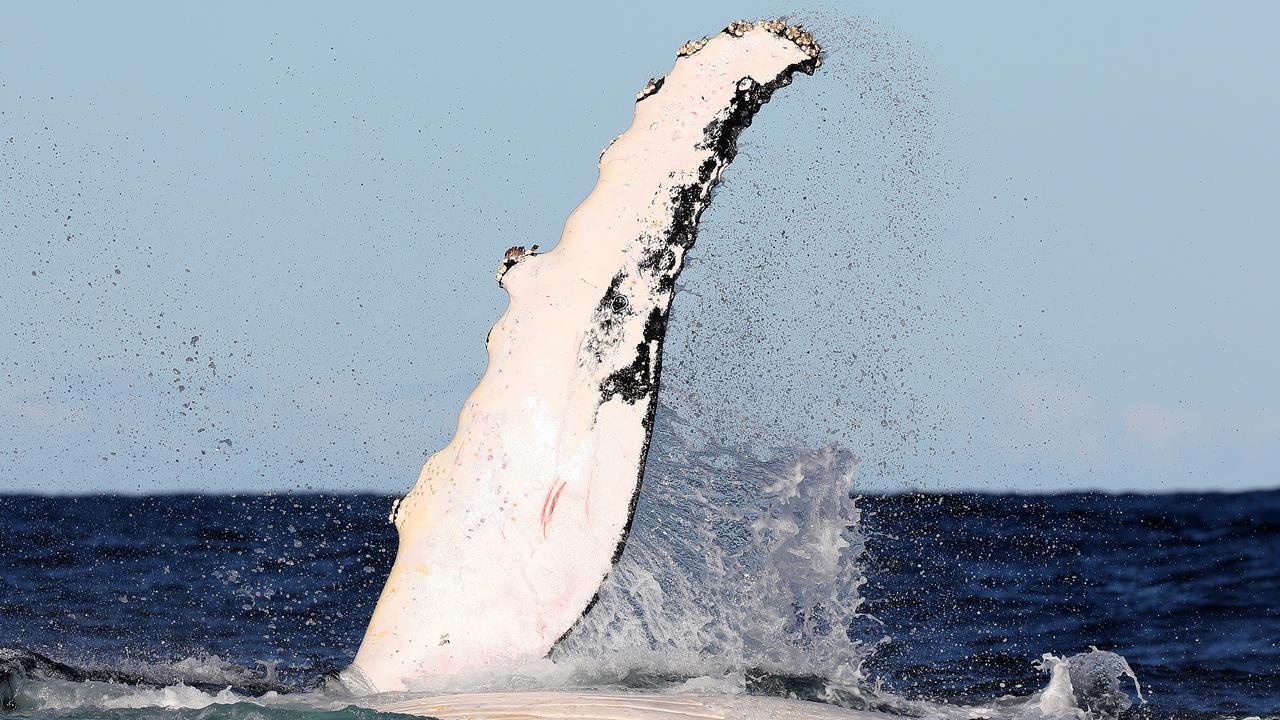Migaloo the white whale spotted in NSW | Best places for whale watching
Australia’s favourite white whale Migaloo has been spotted off the south coast of New South Wales, on his annual migration from Antarctica to Queensland.
Migaloo, Australia’s favourite white whale, has been spotted for the first time this season off the south coast of New South Wales, heading north on his annual migration from Antarctica to Queensland.
Whale watchers expect the beloved mammal to “cruise past” Sydney some time today, and Byron Bay anytime from Wednesday this week.
Those on the east coast hoping to spot Migaloo, who is protected under Queensland and Commonwealth legislation, should grab their binoculars and go to a headland.
Vessels can be fined $16,500 if they come within 500m of the 40,000kg, 15m-long whale.
Breaking News: A white whale possibly #Migaloo has been sighted along the NSW South Coast heading north. Estimated to cruise past Sydney anytime soon and Cape Byron anytime from Wednesday this week. If you are lucky to sight the White Whale please email us Migaloo@migaloo.com.au pic.twitter.com/CjS9GUKGrN
— Migaloo the Whale (@Migaloo1) June 15, 2020
WHO IS MIGALOO?
Migaloo was first spotted in 1991 passing through Byron Bay – at the time, the only documented all-white humpback whale in the world. Thought to be between three and five years old at the time, his name means “white fella” in several Indigenous languages.
In October 2004, researchers from Southern Cross University’s Whale Research Centre were able to collect sloughed skin samples from Migaloo when he breached, sending small pieces of skin into the water. These were collected and analysed for DNA, the White Whale Research Centre said.
From these samples, it was confirmed Migaloo is a male, believed to have been born in 1986. A genetic fingerprint for Migaloo was also obtained, allowing researchers to check for relatives of Migaloo among the other whales they had samples from, as well as to check whether Migaloo is the father if they obtain skin from a calf.
“He is now well and truly fully grown and fully mature. He’s mature socially and physically,” adjunct fellow at Southern Cross University and founding director of The Oceania Project, Dr Wally Franklin, said last year, adding Migaloo is now around 30 years old.
“It doesn’t appear that he has had any issues with predators and he has an expectation to living as long as 100 years, which is the generally believed life expectancy.”
Dr Franklin said the sightings of Migaloo – which have occurred “just about every year of his life” – have been valuable in confirming humpback whales’ migratory timing.
There are now around three other known all-white humpback whales in the world – Bahloo, Willow and Migaloo Junior – suspected to be albino whales, though known as “hypo-pigmented” humpbacks.
Concerns were sparked last year over Migaloo’s health when he was spotted heading south again at the end of July and his skin appeared discoloured.
While Dr Franklin said the parasites (lice) that live on humpback whales are quite natural, when the whale can’t travel at its full normal speed the lice aren’t washed off and can cause discolouration – and can also indicate the animal may not be well.

WHEN IS THE BEST TIME TO SEE WHALES?
This year’s bumper whale watching season is expected to run until November, with up to 30,000 humpbacks making the 10,000km trek north from the Antarctic to subtropical waters, where they mate and give birth.
The exact timing of the migration depends on water temperatures, sea ice, predators and the availability of food.
It’s estimated Migaloo began his migration north in April – but is appearing off the east coast earlier than usual this year. He is normally spotted around July or August. He then tends to head south again in September or October.
WHERE ARE THE BEST SPOTS?
While Migaloo can only be sighted along the east coast, between May and November you can spot southern right whales heading to the temperature breeding waters off South Australia and Victoria.
Humpback whales, meanwhile, continue north to the Great Barrier Reef and the Kimberley, while orcas are often spotted off the southern coast of Western Australia.
Here are the best spots around Australia to sneak a peek of the mammals:
• Tasmania: From May to July and September to December, Great Oyster Bay off the Freycinet Peninsula, Frederick Henry Bay and the Mercury Passage off Maria Island are great places to spot whales.
• Western Australia: Between June and November, Flinders Bay, Geographe Bay in Dunsborough, Bremer Bay and Broome are all renowned for whale sightings. Ningaloo Reef in Exmouth also sees the highest number of humpback whales in the southern hemisphere.
• NSW: From May until late November, Byron Bay, Eden, Merimbula, the Shoalhaven Heads, Crookhaven Heads Lighthouse, Jervis Bay and Penguin Head at Culburra Beach offer great outlooks for whale watching. Sydneysiders walking the Bondi to Coogee coastal track also often spot whales in June and September.

• South Australia: Victor Harbor and the jagged coastline in Ceduna are prime whale watching spots from June until September.
• Queensland: Queensland’s whale watching hot spot is Hervey Bay, where whales are spotted between May and November. The Sunshine Coast and Whitsunday Islands are also famed for their whale encounters.



